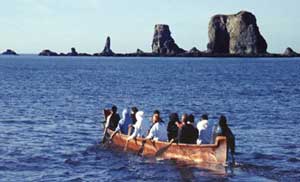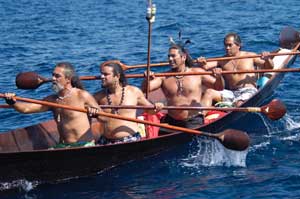|
Native Cultures and the
Maritime Heritage Program
The Maritime Heritage Program is not only involved in the protection of physical artifacts (cultural, historical, and archaeological resources), but also in increasing appreciation of the many human connections to the sea. This includes an effort to support, understand and learn from diverse maritime histories and experiences, and particularly greater appreciation of indigenous maritime cultures, traditional seafaring, host culture perspectives and traditional marine environmental knowledge.
The Maritime Heritage Program seeks to support research into seafaring traditions and the preservation of maritime folklore and knowledge. Understanding the true human dimensions of our protected marine areas is incomplete without an awareness and recognition of the special cultural ties these areas have to indigenous seafaring cultures. Gaining an awareness of the great variety of human connections to the sea can help us all become better stewards of our ocean resources.
Some examples of host culture and indigenous seafaring connections to our National Marine Sanctuary System:
Olympic Coast National Marine Sanctuary
 |
| Canoe and paddlers near Needles rocks. (Photo: OCNMS) |
|
|
Human presence on the Olympic Coast predates the historical record and attests to the subtle understandings of the marine environment. Following western contact, significant rights were reserved by the members of the four Olympic Coast tribes - the Makah, Quileute, Hoh and Quinault. Established treaties recognized the profound relationships between Native Americans and the sea.
 |
| Greeting ceremony during Tribal Journeys. (Photo: OCNMS) |
|
|
The Olympic Coast National Marine Sanctuary was designated with support from the four tribes. In supporting the sanctuary, tribal resource managers saw the promise of a partner in preserving marine resources and the cultural links to the marine environment that Native Americans forged over the millennia. Today the tribes play crucial roles in assisting the sanctuary to shape policy, research and education programs through ongoing consultations, joint projects, and as members of the Sanctuary Advisory Council. On a day-to-day basis the sanctuary and the tribes act collaboratively, different perspectives focusing on the long-term health of a common priceless ecological and cultural legacy.
Channel Islands National Marine Sanctuary
 |
| Chumash paddlers crossing the channel in traditional Tomol canoe. (Photo: Bob Schwemmer, CINMS) |
|
|
The Chumash are the indigenous maritime people of the California coast from Malibu to San Luis Obispo, the Channel Islands, and inland as far as Bakersfield. One of the distinctive features of the Chumash and their neighbors to the south is their development of a highly organized regional trade network using watercraft. The islanders were integral links in this intensive trading system. A crucial component of the Chumash settlement and trade network was the development of the unique plank canoe called the tomol. This sea-worthy vessel allowed mid-channel fishing, as well as transportation of people and large amounts of material cargo between the islands and the mainland. Today both non-Indian residents and the traditional cultures of the area share the waters surrounding the Channel Islands. Attesting to the long residency of the indigenous people at the islands are the animal and human remains of perhaps the earliest island inhabitants, dating back more than 12,000 years. Historically, the islands were the home of the Island Chumash, who continue to travel to the islands in tomols.
Northwestern Hawaiian Islands
 |
| Polynesian voyaging canoes Hokule`a (foreground) and Hawai`iloa under sail. (Photo: NWHICRER) |
|
|
Long before Western ships sighted the Northwestern Hawaiian Islands (NWHI), Kanaka ‘Oiwi (Native Hawaiians) and other Polynesians journeyed in large double-hulled canoes to these resource-rich islands and atolls as they explored the vast Pacific Ocean. Mele (song, chant) that have been passed down through Native Hawaiian oral traditions, refer to islands beyond the main Hawaiian Islands and recall the travels of seafaring ancestors on their way to and from the Pae ‘Aina o Hawai‘i (Hawaiian Archipelago). Physical remnants of wahi kupuna (ancestral places) at Nihoa and Mokumanamana (Necker) islands indicate use of these islands and the surrounding oceans by the ancients for centuries.
The NWHI are intimately connected to Kanaka ‘Oiwi and the main Hawaiian Islands on genealogical, cultural, spiritual and historical levels. The natural elements (land, wind, rain) and creatures of the northwestern islands are considered primordial ancestors and therefore the older relatives of living Kanaka ‘Oiwi. Both share an interdependent, ‘ohana (family-based) relationship that requires malama (care) and kia‘i (guardianship) for the older siblings who, in turn, provide for the well being of the younger. These traditions remind us of the time-honored Native Hawaiian value of kuleana (responsibility) to care for this unique, fragile place and its many resources through strong conservation and protection principles. The need to malama ka pae ‘aina (care for the archipelago) continues as we look toward the future.
The Executive Order that established the Northwestern Hawaiian Islands Coral Reef Ecosystem Reserve gives special recognition to Native Hawaiians and specifically refers to allowable actions such as culturally significant, noncommercial subsistence, cultural and religious uses within the Reserve that are consistent with long-term protection of NWHI marine resources. The Reserve is working with the Native Hawaiian community to learn more about the cultural significance of this region and has also worked with partners to coordinate trips by Hokule‘a, the traditional double-hulled voyaging canoe, to the NWHI and associated outreach efforts.
Hawaiian Island Humpback Whale National Marine Sanctuary
Ocean stewardship is deeply embedded in the Native Hawaiian culture. The HIHWNMS recognizes the importance of Native Hawaiian cultural traditions and its relationship to the long-term health of Hawaii’s oceans. The HIHWNMS works to facilitate Native Hawaiian values for the protection of the kohola (whale) and Hawaii’s marine environment.
The sanctuary continues to work to understand the relationship between humpback whales and the ancient Hawaiians. Within Hawai`i’s oral and written history there is some evidence, such as petroglyphs, legends, legendary place names, and artifacts indicating that Hawaiians were aware of the presence of the kohola in Hawaiian waters, yet many still wonder why there is such a scarce amount of information on an animal that has such a large impact on today’s society. Theories vary from those that say whales may not have been present in Hawaiian waters until the past two centuries to those that say that Hawaiians may have viewed the whale as such a sacred creature that information was kept secret and reserved to only a chosen few. Regardless of the answer, it is unquestionable that today’s society can learn from the connection between Native Hawaiians and the ocean.
Teaching the community how to malama (care for) the ocean as the ancient Hawaiians did may be one of the most important lessons that the sanctuary could relay. To do this, the sanctuary partners with the non-profit organization `Ao`ao O Na Loko I`a O Maui to protect, restore, and educate the public about traditional Native Hawaiian values, practices and traditions. A historical Native Hawaiian Fishpond that fronts the Sanctuary property on Maui provides a natural classroom for these education efforts. Also, the Sanctuary Advisory Council, which provides advice to sanctuary management on current issues, includes a member and an alternate from the Native Hawaiian community which helps to ensure that the Native Hawaiians have a voice in decisions being made by the sanctuary.
Fagatele Bay National Marine Sanctuary
 |
| Flanked by attendents, the village taupo, a ranking young woman, prepares the `ava for and `ava ceremony. Called kava in other parts of the Pacific, `ava is made from the root of the Piper methiscum tree, and is steeped to make a mildly narcotic drink. An `ava ceremony is deeply significant to Samoans and will begin important meetings. (Photo: Kip Evans) |
|
|
The Samoan islands, which comprise two political entities, American Samoa in the east, and Samoa in the west, are considered to be the birthplace of Polynesia. Settled from the west at least 4,000 years ago, the Samoan archipelago has been inhabited long enough that pre-western mythology and religion began with local creation stories that have echoed throughout the huge Polynesian "triangle" that ranges from New Zealand to French Polynesia and Hawaii. Heroic ocean navigators and sailors, Polynesians plied the vast Pacific placing explorers and settlers in virtually every inhabitable island in the central north and south Pacific. Most of this Polynesian seafaring tradition has been lost as Samoans embraced western navigation and motorized vessels.
Samoans still retain many of their other cultural traditions. Most young Samoans still grow up hearing and speaking Samoan. Their strong family orientation dominates the cultural landscape, although the younger generation often chaffs from the lack of independence that typifies western cultural mores. In general, Samoans control their culture, and the overlay of outside cultural influences appears to be largely selective. DVDs, washing machines, cars, western style dress, houses and foods have certainly been part of those choices. But preeminence of family decisions, adherence to land and sea tenure traditions, and respect for cultural ceremonies and responsibilities prevail.
As the island population grows, and immigration from other Pacific areas influences changes through the territory, the dynamic between economic development and conservation of natural resources will continue to challenge local politics. The sanctuary strives to find a reasonable balance between the two, recognizing the need for the former, and the threat to the latter. We strive always to encourage an island stewardship, to preserve the special natural and cultural elements that make these islands special.
|











